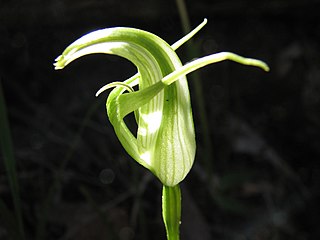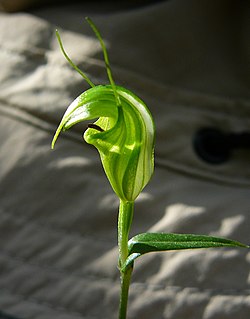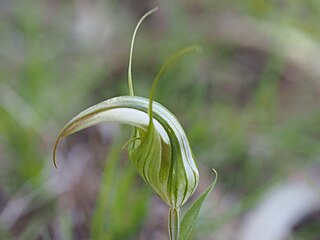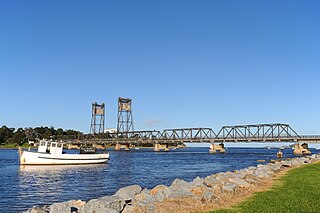
Pterostylis coccina, commonly known as the scarlet greenhood, is a species of orchid endemic to eastern Australia. As with similar greenhoods, the flowering plants differ from those which are not flowering. The non-flowering plants have a rosette of leaves flat on the ground but the flowering plants have a single flower with leaves on the flowering spike. In this species, the rosette leaves are relatively large and dark green, and the flowers are white, and bluish-green or red. It grows in New South Wales and north-eastern Victoria.

Pterostylis curta, commonly known as the blunt greenhood, is a species of orchid found in south-eastern Australia, Lord Howe Island and New Caledonia. It has a rosette of leaves at its base and a single white and green, forward leaning flower with a brown tip and a twisted labellum.

Pterostylis alpina, commonly known as the mountain greenhood, is a species of orchid endemic to south-eastern Australia. It has a rosette of fleshy leaves at the base and usually only one white flower with green markings and back-swept lateral sepals.

Pterostylis alveata, commonly known as the coastal greenhood, is a species of orchid endemic to south-eastern Australia. As with similar greenhoods, the flowering plants differ from those which are not flowering. In this species, the non-flowering plants have a rosette of leaves flat on the ground but the flowering plants have a single small, shiny green and white flower with leaves on the flowering spike.

Pterostylis fischii, commonly known as Fisch's greenhood, is a species of orchid endemic to south-eastern Australia. As with similar greenhoods, the flowering plants differ from those which are not flowering. The non-flowering plants have a rosette of leaves flat on the ground but the flowering plants have a single flower with leaves on the flowering spike. This greenhood has tawny-coloured flowers, a dorsal sepal with a long thread-like tip and a labellum which is hidden inside the flower.

Pterostylis atrans, commonly known as the dark-tip greenhood or blunt-tongue greenhood, is a species of orchid endemic to south-eastern Australia. As with similar greenhoods, plants in flower differ from those that are not flowering. The non-flowering plants have a rosette of leaves flat on the ground, but the plants in flower have a single flower with leaves on the flowering spike. In this species, the flower is green and reddish brown with a protruding sinus and small club-like tips on the ends of the lateral sepals.

Pterostylis concinna, commonly known as the trim greenhood, is a species of orchid endemic to south-eastern Australia and which usually grows in colonies. It has a rosette of leaves at the base and a single dark green, white and orange-red flower.

Pterostylis revoluta, commonly known as the autumn greenhood, is a species of orchid endemic to south-eastern Australia. As with similar greenhoods, the flowering plants differ from those which are not flowering. The non-flowering plants have a rosette of leaves flat on the ground but the flowering plants have a single flower with leaves on the flowering spike. This greenhood has white and green flowers which have a long, curved, pointed labellum which extends beyond the sinus between the lateral sepals.

Pterostylis aneba is a species of orchid endemic to south-eastern Australia. It is a recently described and poorly-known greenhood similar to Pterostylis alpina and P. monticola. It has a rosette of fleshy leaves at the base of the plant and a single green and white flower. It grows in alpine and sub-alpine habitats.
Pterostylis agathicola, commonly known as the kauri greenhood, is a species of orchid endemic to the North Island of New Zealand. As with similar greenhoods, the flowering plants differ from those which are not flowering. The non-flowering plants have a rosette of leaves flat on the ground but the flowering plants have a single flower with leaves on the flowering spike. It grows almost exclusively in kauri forest and has a relatively large green and transparent white flower.

Pterostylis sp. aff. alata is a species of orchid endemic to New South Wales but which has not yet been formally described. Non-flowering plants have a rosette of leaves but the flowering plants have a single flower with leaves on the flowering spike. This greenhood has a white flower with green markings and a brown-tipped dorsal sepal. It is only known from areas near Armidale where it grows near south-facing escarpments.

Pterostylis daintreana, commonly known as Daintree's greenhood, is a species of orchid endemic to eastern Australia. The non-flowering plants have a rosette of leaves on short stalks but flowering plants have up to ten flowers with rosettes on the side of the flowering spike. The flowers are translucent white with dark green lines and long, downcurved lateral sepals.
Pterostylis dubia, commonly known as the blue-tongued greenhood, is a plant in the orchid family Orchidaceae and is endemic to Tasmania. It has a rosette of fleshy leaves at its base and a dark green and white flower with narrow petals and a dark blue-green labellum.

Pterostylis hildae, commonly known as the rainforest greenhood, is a species of orchid found in eastern Australia. It has a rosette of leaves and when flowering a rosette at the base of a flowering stem with a single green, white and brown flower. It is found in wet forests, including rainforest in New South Wales and Queensland.

Pterostylis longicurva, commonly known as the long-tongued greenhood, is a species of orchid endemic to eastern Australia. As with similar greenhoods, plants in flower differ from those that are not. Those not in flower have a rosette of leaves lying flat on the ground, but plants in flower have a single flower with leaves on the flowering stem. This species has a white and green flower with brown markings and a long, curved, brown labellum.
Pterostylis pulchella, commonly known as the waterfall greenhood, escarpment greenhood or pretty greenhood is a species of orchid endemic to New South Wales. As with similar greenhoods, the flowering plants differ from those that are not flowering. The non-flowering plants have a rosette of leaves flat on the ground but the flowering plants have a single flower with leaves on the flowering stem. This greenhood has a reddish-brown flower with a greenish-white base and protuding labellum with a cleft tip.

Pterostylis reflexa, commonly known as the dainty greenhood, is a species of orchid endemic to New South Wales. As with similar greenhoods, the flowering plants differ from those which are not flowering. The non-flowering plants have a rosette of leaves flat on the ground but the flowering plants have a single flower with leaves on the flowering stem. This greenhood has a relatively large white, green and light brown flower with a long, curved dorsal sepal and a protruding labellum.
Pterostylis russellii, commonly known as Russell's greenhood, is a species of orchid endemic to eastern Australia. Non-flowering plants have a rosette of leaves flat on the ground but flowering plants have a single shiny white and dark green flower on a flowering stem lacking a rosette but with a few spreading stem leaves.
Pterostylis subtilis, commonly known as the thin mountain greenhood, is a species of orchid endemic to New South Wales. It has a rosette of leaves and when flowering a single translucent white flower with dark green lines, a narrow, deeply notched sinus between the lateral sepals and a curved, protruding labellum.

Pterostylis torquata, commonly known as the collared greenhood, is a species of orchid endemic to New South Wales. As with similar greenhoods, the flowering plants differ from those which are not flowering. The non-flowering plants have a rosette of leaves flat on the ground but the flowering plants have a single flower with leaves on the flowering stem. This greenhood has a white flower with dark green and dark brown markings, although in some areas, the flowers lack the brown markings. The sinus between the lateral sepals is platform-like.
























